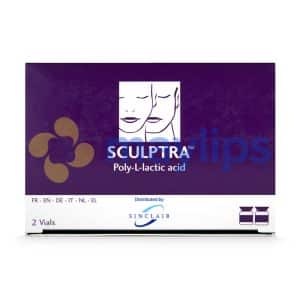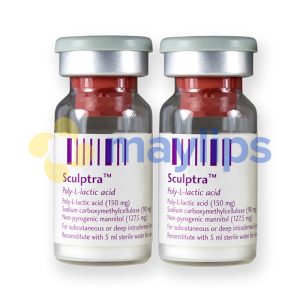Showing the single result
Buy Sculptra Online
Buy Sculptra Online
-


SCULPTRA® 2 Vials
150mg/ml 2 vials
549.00 $ Add To Cart-+BUY SCULPTRA® ONLINE WITH YOUR ORDER AT MAYLIPS.COM
*Disclaimer: Information on Maylips.com is provided for informational purposes only. Self-medication is strictly prohibited. All aesthetic procedures should be provided by the licensed healthcare specialist after the consultation with the personal therapist. The information in this article should not be used for prescribing any medication for the beauty injections.
All brand and medication descriptions in the article are based on the personal opinion and are not endorsed by Maylips.com. The article content was not reviewed for medical validity. Use this article for information and not for a final decision on the procedure.
WHAT IS SCULPTRA AND WHY PURCHASE SCULPTRA?
Sculptra is a semi-permanent soft tissue dermal filler made of poly-L-lactic acid (PLLA) and is manufactured by Galderma Laboratories. Poly-L-lactic acid is a non-toxic, bioresorbable synthetic polymer that has been used widely in the pharmaceutical industry for many years, especially for medical supplies like bone plates, screws, and sutures. A single vial of Sculptra contains a freeze-dried powder that is composed of 150mg of poly-L-lactic acid, 90mg of sodium carboxymethylcellulose, and 127.5mg of mannitol. This powder must be reconstituted with 5mL of sterile water before administering the solution into the affected sites. Each box of Sculptra comes with two vials of the powdered solution and a product leaflet. Needles and sterile water for reconstitution must be obtained separately. Please store Sculptra in a clean room at less than 30ºC, and away from freezing conditions. Once reconstituted, the Sculptra solution can only be kept up to 72 hours and must be stored at a temperature between 5ºC to 30ºC.
WHAT IS SCULPTRA USED FOR?
Unlike other dermal fillers, Sculptra is famed for its gradual volumising effect on depressions in the skin, such as severe wrinkles. The list below is all common uses for which to buy Sculptra. Additionally, this soft tissue implant is great for targeting large areas that are in need of volume restoration, making it more cost and time-effective.
- Nasogenian furrows: These deep wrinkles are commonly known as nasolabial folds, and they are the lines that extend from the corners of the nose to the corners of the mouth. This facial crease, like many other facial blemishes, occurs as the skin loses elasticity due to uncontrollable matters like ageing, and because of repeated facial expressions like smiling.
- Marionette lines: These are the deep lines that extend downwards from the corners of the mouth to the chin. Naturally and without treatment, ageing and habitual expressions weaken the skin structure, making these lines deepen over the years.
- Sunken cheeks: In addition to the usual wrinkle formation and dull skin, changes in health such as unintended weight loss or facial fat redistribution are also signs of the ageing process. This weight loss can give the cheeks a sunken appearance, leading to an overall, strongly noticeable, gaunt look to the face. Furthermore, it has long been known some patients suffering from HIV/AIDS may experience significant fat loss in the cheeks, resulting in a gaunt appearance.
HOW DOES THIS DERMAL FILLER WORK?
The skin obtains its distinct elasticity and firmness from a vital protein called collagen. Collagen is a structural protein that is present in many components of the body, including the skin and other connective tissues. When the skin quality is young and healthy, collagen production and functionality is at its peak, preventing imperfections from appearing . But as time progresses, the ageing process sets in and impedes the synthesis of collagen. Other factors including, but not limited to chronic sun exposure and smoking introduce destructive free radicals, which aggravate the weakened skin structure. With the combination of habitual expressions and lack of skincare over an extended period of time, skin depressions become extremely severe and noticeable.
Sculptra works not only as a volumising implant, but Sculptra also helps to stimulate the body’s production of collagen through neocollagenesis. The microparticles of poly-L-lactic acid that are present in Sculptra help to revive all or many of the collagen production centres located in your body, otherwise known as fibroblasts, with the purpose to generate more collagen. As a result, sunken areas and wrinkles subsequently undergo changes and get filled in gradually and subtly. Patients can enjoy a plumper and more resplendent visage without looking overcorrected; a common worry for anybody considering options for cosmetic improvement.HOW TO INJECT SCULPTRA AFTER I SHOP?
Sculptra injections are considered a medical procedure and should only be conducted by licensed physicians specialising in aesthetic treatments. Furthermore, stringent aseptic standards are necessary when performing treatment, so as to reduce the risk of infections and cross-contamination. Since Sculptra comes in the form of a powder, it must first be reconstituted with 5mL of sterile water. The resulting Sculptra suspension is then ready to use, as it is sterile and non-pyrogenic. Just before the Sculptra treatment session, clean the proposed treatment areas and apply pain-relieving agents if necessary. To completely assemble the medical device, secure a 26G needle to the syringe. Inject Sculptra slowly into the deep dermis. Once the pre-determined areas have been corrected adequately, massage the skin to distribute the dermal filler evenly. Patients can apply a cold compress to effectively reduce swelling without inflammation reduction product use. Discard any remaining reconstituted Sculptra solution.
HOW LONG DOES SCULPTRA LAST?
Since the product Sculptra works as a collagen stimulator, all of the improvements from Sculptra treatment are observed gradually. A full cosmetic improvement procedure usually consists of 2 to 3 injection sessions, though this will vary, taking into account the severity of the correction and the condition of the skin. These sessions should be scheduled 4 to 6 weeks apart to maximize collagen synthesis. Patients will notice, with each application, improvements that can last up to 2 years. Since this is a semi-permanent bioresorbable filler, it will naturally undergo biodegradation and be absorbed by surrounding cells over time. The duration of results varies across patients depending on factors such as their age, skin condition, and lifestyle.
IS THIS PRODUCT SAFE?
Yes, Sculptra is a very safe dermal filler. Along with all the other information about the safety of this product, its active ingredient, PLLA, has been used as suture material for years due to its nontoxic nature. However, patients who are pregnant or breastfeeding should refrain from receiving treatment with this dermal filler. The same applies to pediatric patients as well as those with a tendency to develop hypertrophic scarring. To assure potential patients of the safety of them using this product in consideration of their medical history, discuss with them during consultation for available cosmetic improvement options.
WHAT IS THE DIFFERENCE BETWEEN SCULPTRA AND JUVEDERM VOLUMA?
More than other similar products, Juvederm Voluma is a dermal filler that is frequently compared to Sculptra. Both of these soft tissue implants deliver long-lasting volumising effects on sunken areas, but that is where the similarities end. The main difference between these 2 popular products is the filler material itself. Juvederm Voluma is made of cross-linked hyaluronic acid, which can provide instantaneous results once injected. Additionally, the hyaluronic acid exists in the form of a highly malleable gel that can be injected easily without any process of reconstitution being required. In light of this, Voluma only lasts for up to 18 months, much shorter than the average 24 months of Sculptra. A fact to take into account when considering to buy Sculptra products.
WHAT ARE THE SIDE EFFECTS?
Patients might experience some inflammatory reactions at the injection site, although there is no reason for concern on their part.
COMMON SIDE EFFECTS:
- Pain
- Swelling
- Redness
- Itchiness
- Bleeding
- Temporary lumps
These side effects are very mild in nature and should abate within a few days. On rare occasions, some patients may experience more serious reactions such as these:
SERIOUS SIDE EFFECTS
- Inflamed nodules at the injection site
WHAT IS IT MADE OF?
To explain the compilation of ingredients in this product; Sculptra is a semi-permanent soft tissue filler that contains poly-L-lactic acid as an active ingredient. This same solution also contains sodium carboxymethylcellulose and mannitol, made possible to be supplied as a freeze-dried powder that must be reconstituted aseptically with 5mL of sterile water.

